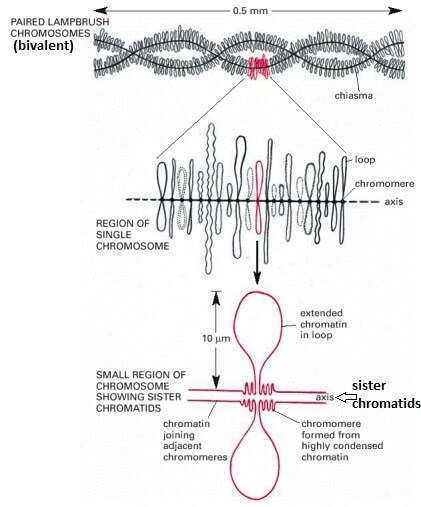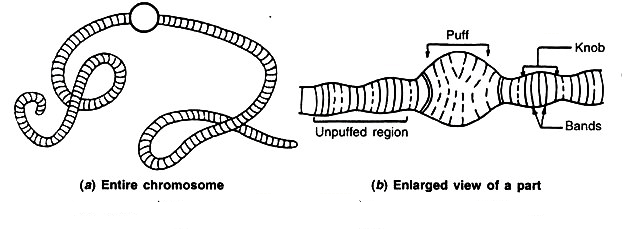Giant ChromosomesAs the name suggests, the giant chromosomes are very large in size as compared to normal chromosomes. They are also called mega chromosomes. The Giant chromosomes are of two types; Lampbrush chromosome and Polytene chromosome. The term 'giant chromosome' was given by Winchester. i) Lampbrush chromosomeIt is a giant chromosome that is found in the oocytes or immature egg (germ cells in the ovary) of most of the vertebrates such as fishes, amphibians, birds and reptiles, and in some insects. However, they are not found in mammals. They are generally found in oocytes as the DNA content is very high in these cells. They are formed in response to the active synthesis of mRNA molecules for egg cells for their future use. The characteristic features of Lampbrush chromosomes include fine lateral loops that originate from the chromomeres in the diplotene stage of prophase first of meiosis in both animal species, vertebrates and invertebrates. So, they can be seen only in the prophase first's diplotene stage of meiosis. However, they are generally smaller in invertebrates than vertebrates. The lateral loops give it its characteristic lamp brush like appearance. These chromosomes were first observed by Walther Flemming in 1882 in the oocytes of Salamander and described by Ruckert in shark oocytes in 1892. The name Lampbrush chromosome is also given by Ruckert based on their resemblance with a lamp cleaning brush. Structure of Lampbrush chromosomeThey are synapsed homologous chromosomes that measure around 1500 to 2000 micrometre in length. They occur in bivalent form as they are meiotic bivalents (one maternal and paternal). Each bivalent is made of two homologous chromosomes (4 chromatids) connected by chiasmata. 
The longitudinal axis from which loops arise is made of a single DNA molecule. Numerous bead-like structures called chromomeres are arranged in a linear fashion along this axis. Two symmetrical lateral loops in opposite direction emerge from each chromomere that can expand or contract in response to different environmental conditions. The opposite loops are always symmetrical. Each chromosome in the bivalent has two of them one for each chromatid. However, the centromeres of each of the chromosomes do not have loops. There are around 10000 loops per chromosome set or haploid set. The lateral loops contain 5 to 10 % of DNA. It consists of transcriptionally active DNA that can make a large amount of mRNA required for the synthesis of yolk. The mass of the chromomeres also reduces at the point from where loops arise as due to the corresponding loop formation chromomere material spin out into the lateral strands. The length of the loop is 10 micrometre and its diameter is around 1 micrometre. The Loops are rich in RNA and form around an axis made of single DNA molecule that gets unfolded from the chromosome during RNA synthesis. The loop is covered by a matrix made of RNA transcripts and binding protein attached to them. Its major function of Lampbrush chromosome is to help in RNA synthesis and lipid or yolk synthesis. Biological significance of Lampbrush chromosomes:
II) Polytene Chromosome:It is also a giant chromosome that consists of thousands of DNA strands. However, it is not as large as Lampbrush chromosome. These chromosomes were first observed in the salivary glands' cells of Chironomas larvae (Diptera). The cells in salivary glands of these larvae are so large that they can be seen by using a dissecting microscope. The nucleus of these cells is also very large around 25 microns in diameter and chromosomes is also up 50 to 200 times more in size than chromosome of other body cells of the organism. They are large due to their high content of DNA. Discovery of Polytene ChromosomesThis type of giant chromosomes was first observed by E.G. Balbiani in 1881. However, he did not conclude them to be chromosomes. Later, they were studied by Korschelt and Corney in 1884. Besides this, Bauer and Heitz also studied these chromosomes in 1933 in Bibio hortulanus larvae. Later in 1933, they were described for the first time by Theophilus Painter in the salivary glands of Drosophila. It got its name due to its large size and numerous strands (poly means many and tene means strands). However, it is also known as salivary gland chromosome as it was found in the cells of salivary glands of Drosophila. The name or term polytene was given by Kollar due to the presence of lots of chromonemata or DNA strands in them. They are visible in the interphase stage of cell division. How is Polytene Chromosome formed?The giant chromosome Polytene arises due to the multiple or repeated replication of the chromosomal DNA without nuclear division or endomitosis. The nuclear envelope remains intact. It does not rupture and spindles are not formed. So, continuous replication (endoreplication) of DNA is going on without any division. As a result, the daughter chromatids do not separate and remain joined side by side, which give rise to polytene chromosome. This type of giant chromosomes is visible during the interphase and prophase stage of mitosis. So, it is formed due to repeated replication of homologous chromosomes in which the replicated or newly formed sister chromatids do not get separated. Furthermore, there could be around 1000 identical DNA molecules aligned laterally in the polytene chromosome so multiple arms can be seen as chromatids are not separated. Structure of Polytene ChromosomeThe arms of the chromosome show a series of alternating dark and clear bands called interbands. These bands are formed as the amount of chromatin varies along the linear axis of this chromosome. The regions where the concentration of chromatin is high appear dark as is known as chromomeres or dark bands, whereas, the regions with a low concentration of chromatin are called interchromomeres or interbands. 
Around 85% DNA of a polytene chromosome is found in the dark bands and the remaining 15% is found in the interbands. The dark band contains more DNA but less RNA, whereas, the interband contains more RNA than DNA. This pattern of bands remains the same for a particular species. The dark bands are euchromatic regions. Some dark bands of the chromosome may swell up or puff out to form extensions or puffs called chromosomal puffs or Balbiani rings. The formation of puffs is known as puffing. These puffs are formed due to active DNA transcription involved in the synthesis of different types of RNA. So, puffs are the active sites where the RNA synthesis is going on. Besides this, the chromonemata uncoil to form many loops in the puffs. Besides this, paternal and maternal chromosomes remain aligned side by side in polytene chromosomes and this phenomenon is known as somatic pairing. Polytene chromosomes are found in cells during developmental stages, e.g. during the rapid development of an organ, which is needed to perform specific functions. Polytene chromosomes are found very useful for the study of various features of the interphase chromosome as well as for the analysis of the whole genome. Significance or function of Polytene ChromosomeThey increase the cell volume and DNA content so it has multiple copies of genes that allow a high level of gene expression. For example, in Drosophila melanogaster, the polytene chromosomes of the larval salivary glands help produce a large amount of adhesive mucoprotein, a type of glue before pupation. The bar phenotype of kidney-shaped eyes in this fly is also produced due to the polytene chromosomes. The interbands interact with the active chromatin proteins and serve as binding sites for RNA polymerase II to begin replication and remodelling of nucleosome or short fragments of DNA.
Next TopicWhat is a gene
|
 For Videos Join Our Youtube Channel: Join Now
For Videos Join Our Youtube Channel: Join Now
Feedback
- Send your Feedback to [email protected]
Help Others, Please Share










